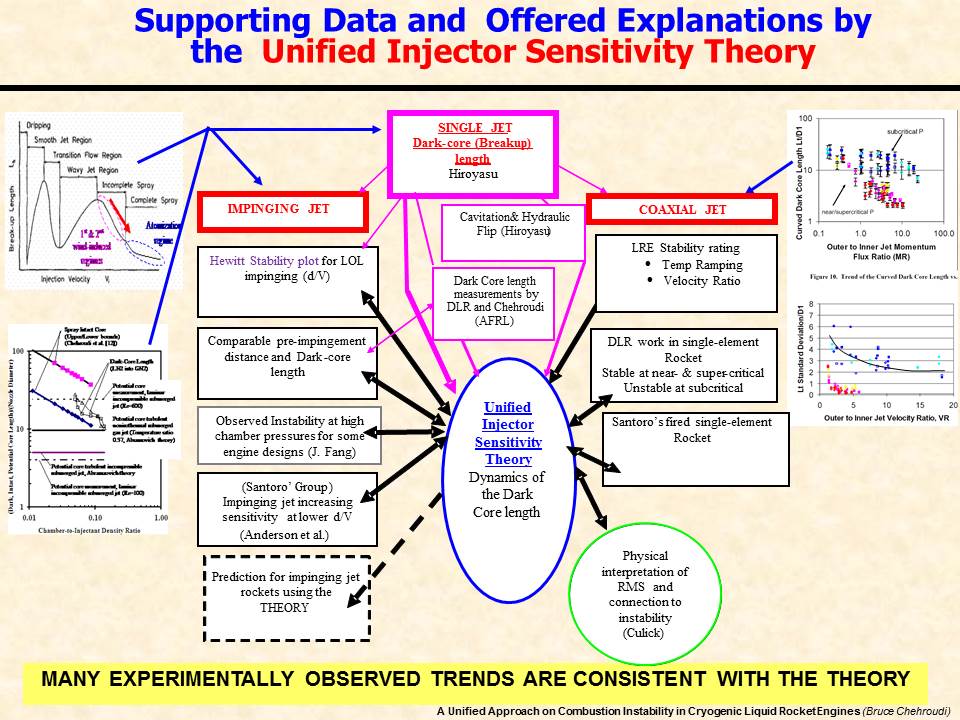Advanced Technology
Consultants |
home | help | email |
Welcome to

Advanced Technology Consultants
Laguna Niguel, California
USA 92677
Tel: 949 467 9233
(001 prefix outside USA)
Lugano, Ticino
Switzerland 6900
|
Combustion Instability
Theory by Dr. B. Chehroudi |
 |
|
A Physical Hypothesis for the Combustion Instability in Cryogenic Liquid Rocket Engines
Acoustic combustion instability has been
one of the most complex phenomena in liquid rocket engines, and
therefore difficult to fully understand, control, and In this paper, however, the author would like to propose a physical picture based on experimental results and intuitive arguments to describe a possible coupling nature/strength between the chamber acoustics and injectors or near-injector processes in cryogenic liquid rocket engines.
In summary, an attempt has been made to portray a
fluid dynamical perspective and link a hypothesis proposed here to
observations made in cold flow injector studies, subscale fired
engines, and full-scale production engines with an aim to offer a
sketch of a theory being consistent with most observations
pertaining to combustion instability. Based on the author’s previous work on intrinsic sensitivity of the dark-core length in a coaxial-jet-like injector in cold sub- and supercritical conditions, it is proposed that a similar phenomenon pertaining to the dark core in impinging-jet injectors is to be considered, attempting to offer underlying fluid mechanical reasons for the injector-caused combustion instabilities in LRE. The basic premise here is that when an important dynamic feature, such as the dark-core or breakup zone, of an injector design becomes sufficiently sensitive to thermofluid parameters of its environment, it is highly likely that this could strengthen the feedback link thought to be critical in the amplification process and hence push the system into an unstable operating state. Evidences cited suggest that the enhanced sensitivity of impinging-jet injectors to their environment occurs when the mean dark-core or break up length of one or both jets forming the impingement reaches a critical value, being of the same order as the pre-impingement length. Feasibility of such a scenario is explored by comparing the range of pre-impingement length values for engines and some recently measured dark-core lengths for cryogenic jets at density ratios of interest. It is then hypothesized that the stable-unstable transition boundary in the Hewitt stability plot is when the core length of one or more of the jets of the impinging jet injector becomes comparable to the pre-impingement distance. This proposed hypothesis is able to offer a consistent explanation of why an engine design based on impinging jets becomes unstable when Hewitt stability parameter (dn/V) is decreased. While work is needed to make a transition from a hypothesis to an established fact, there is sufficient published information in favor of the hypothesis to make it a strong possibility amongst others previously proposed. Finally, the readers are cautioned that as some atomization results from cold studies are linked to fired sub- and full-scale engines, more targeted investigations guided by the hypothesis on the dynamic behavior of the dark-core length and width in cold and fired coaxial and impinging-jet injectors are justified and highly recommended.
Dr. Chehroudi's presentation of the Unified Injector Sensitivity Theory at the 47th American Institute of Aeronautics and Astronautics (AIAA) Aerospace Sciences Meeting, Orlando, Florida, January 5-8, 2009.
Back to Top of This
Page Copyright 2017 - Advanced Technology Consultants- All Rights Reserved |
|


